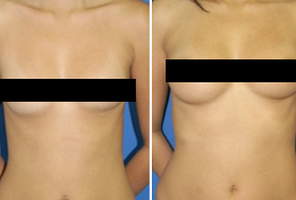Laparoscopic adjustable gastric banding is a restrictive procedure that connects a balloon to a band around the upper part of the stomach. A reservoir is placed under the skin and is used to inflate the balloon and adjust the gastric band. With the inflation of the balloon the gastric band tightens and decreases the amount of food passing through at the given time. When the balloon is deflated the band loosens and the weight loss begins to be reduced. The LAP-BAND ® System, Swedish Adjustable Band and the Mid-Band are the different types of bands for the procedure.
Unlike the other restrictive procedures, LAGB does not permanently alter the anatomy of the stomach or small intestines. LAGB can be a reversible procedure and it produces no risk of severe nutritional deficiencies. Based on these facts, LAGB may be considered to be a safer procedure than the gastric bypass or malabsorptive procedures. However, weight loss induced by LAGB is lower. Weight-related problems have improved with LAGB such as sleep apnea, type II diabetes asthma, and hypertension, but the amount remains less that of gastric bypass procedures.
While some studies have documented weight loss equal to RYGBP with fewer complications, other groups have had disappointing outcomes. Some studies document a substantial number of patients who have required re-operation for long-term complications of the adjustable band (such as for port problems, erosions and slippage, or inadequate weight loss). In addition, conversion of a failed LAGB to another bariatric procedure may be technically more difficult and associated with more complications than with a first time operation.
LAP-BAND® Advantages
Some of the advantages of a lap band procedure may include:
- 47.9% of type 2 diabetes cases are resolved post operation.
- There are significant improvements in cholesterol, including a boost in HDL levels.
- 70.8% of hypertension cases are improved.
- Patients tend to lose roughly 47% of their excess weight.
- Food passes through the digestive tract in the usual order, allowing it to be absorbed fully by the body.
- Band can be adjusted to increase or decrease restriction via an access port.
- This is a procedure that can be reversed.
LAP-BAND® Risks
Risks of a lap band procedure may be the following:
- The port may leak or twist, requiring an operation to correct the problem.The lack of fullness after eating is a feeling some may not be satisfied with.
- Dumping syndrome, used as a warning mechanism, does not occur.
- Band may erode into the stomach wall.
- Band may move or slip.
- Weight loss is slower than that following Roux-en-Y gastric bypass surgery.
LAP-BAND® Related Articles
Disclaimer: This information is intended only as an introduction to this procedure. This information should not be used to determine whether you will have the procedure performed nor does it guarantee results of your elective surgery. Further details regarding surgical standards and procedures should be discussed with your physician.
By OnlineSurgery Staff
Updated: November 13, 2008

